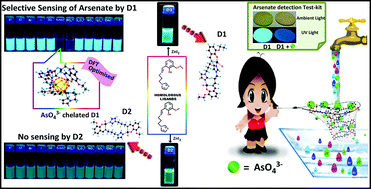Effect of O-substitution in imidazole based Zn(ii) dual fluorescent probes in the light of arsenate detection in potable water: a combined experimental and theoretical approach†
Abstract
Efficient detection of arsenate (AsO43−) from contaminated drinking water extracted from underground has become a matter of utmost necessity and an exquisite challenge owing to the growing public health issue due to arsenicosis. In order to combat this we planned to detect arsenate with the naked eye under UV light using a novel chemosensor material whose structure and functioning as a sensor could be certified mechanistically. Hence we were encouraged to synthesize two differently O-substituted imidazole based homologous ligands: C1 (HL1 = 2-((E)-(3-(1H-imidazole-1-yl)propylimino)methyl)-6-ethoxyphenol) and C2 (HL2 = 2-((E)-(3-(1H-imidazole-1-yl)propylimino)methyl)-6-methoxyphenol). To accomplish the purposeful exploration of the luminescent sensor, we considered Chelation Enhanced Fluorescence (CHEF) and kept on searching for a metal cation that would be able to turn on the fluorescence of the ligands. Considering Zn(II) as the most suitable candidate, luminescent complexes D1 and D2 ({[Zn2(L1)2(I)2](DMF)} and [Zn2(L2)2(I)2](DMF), respectively) were synthesized and characterized by SXRD, UV-Vis, FT-IR, and photoluminescence spectroscopy. In spite of the resemblance in the solid state structures of D1 and D2, the selective response of D1 towards arsenate with high quenching constants (2.13 × 106), unlike D2, has been demonstrated mechanistically with steady state and time resolved fluorescence titration, solution phase ESI-MS spectral analysis and DFT studies. The selectivity and sensitivity of the sensor D1 explicitly make this material a potent candidate for arsenate detection due to its very low detection limit (8.2 ppb), low cost and user friendly characteristics. Real life implementation of this work in a test strip is expected to prove beneficial for public health to identify arsenate polluted water.



 Please wait while we load your content...
Please wait while we load your content...